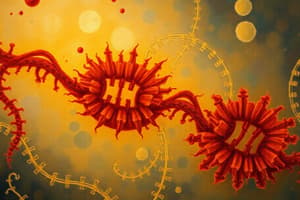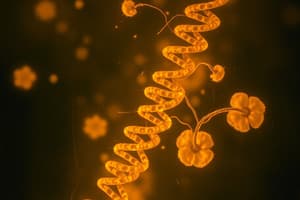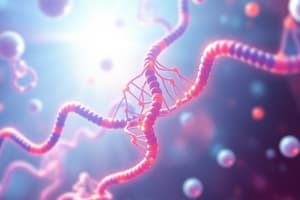Podcast
Questions and Answers
What type of operon is illustrated in Model 1?
What type of operon is illustrated in Model 1?
- Inducible operon (correct)
- Repressible operon
- Negative control operon
- Positive control operon
Consider the operon in Model 1. Other than the gene that regulates the operon, how many genes are contained within the operon?
Consider the operon in Model 1. Other than the gene that regulates the operon, how many genes are contained within the operon?
Three
In Model 1, where on the DNA strand does RNA polymerase bind to start transcription?
In Model 1, where on the DNA strand does RNA polymerase bind to start transcription?
The RNA polymerase binds to the promoter.
Which direction is the RNA polymerase moving in Model 1?
Which direction is the RNA polymerase moving in Model 1?
In which diagram of Model 1 is transcription and translation occurring successfully, diagram A or diagram B?
In which diagram of Model 1 is transcription and translation occurring successfully, diagram A or diagram B?
Match the purpose with each of the sections in the operon in terms of gene transcription:
Match the purpose with each of the sections in the operon in terms of gene transcription:
What protein does the regulatory gene in Model 1 produce?
What protein does the regulatory gene in Model 1 produce?
To what section of the operon does the repressor protein bind?
To what section of the operon does the repressor protein bind?
Propose an explanation for why transcription is not occurring in diagram A.
Propose an explanation for why transcription is not occurring in diagram A.
When an inducer molecule attaches to the repressor protein, what happens to the repressor protein?
When an inducer molecule attaches to the repressor protein, what happens to the repressor protein?
How does the change in the repressor protein allow transcription of the genes in operon to occur?
How does the change in the repressor protein allow transcription of the genes in operon to occur?
Explain what would happen within the lac operon when lactose levels are LOW.
Explain what would happen within the lac operon when lactose levels are LOW.
Explain what would happen with the lac operon when lactose levels are HIGH.
Explain what would happen with the lac operon when lactose levels are HIGH.
In Model 2, where on the DNA strand does RNA polymerase bind to start transcription?
In Model 2, where on the DNA strand does RNA polymerase bind to start transcription?
In which diagram of Model 2 is transcription and translation occurring successfully, diagram A or B?
In which diagram of Model 2 is transcription and translation occurring successfully, diagram A or B?
Does the regulatory gene in Model 2 produce a protein that is an active or inactive repressor naturally?
Does the regulatory gene in Model 2 produce a protein that is an active or inactive repressor naturally?
Describe the role of the corepressor molecule in the repressible operon system shown in Model 2.
Describe the role of the corepressor molecule in the repressible operon system shown in Model 2.
What compound could serve as the corepressor of the TRP operon in E. coli?
What compound could serve as the corepressor of the TRP operon in E. coli?
Compare and contrast an inducible operon and a repressible operon.
Compare and contrast an inducible operon and a repressible operon.
Which type of operon, inducible or repressible, would an organism likely use to produce enzymes needed to metabolize a nutrient in its environment?
Which type of operon, inducible or repressible, would an organism likely use to produce enzymes needed to metabolize a nutrient in its environment?
Which type of operon, inducible or repressible, would an organism likely use to produce enzymes needed from smaller molecules?
Which type of operon, inducible or repressible, would an organism likely use to produce enzymes needed from smaller molecules?
Propose an explanation for why operons evolved in prokaryotes.
Propose an explanation for why operons evolved in prokaryotes.
In which diagram of Model 3 is transcription occurring successfully, A or B?
In which diagram of Model 3 is transcription occurring successfully, A or B?
In Model 3, where on the DNA strand does RNA polymerase bind to start transcription?
In Model 3, where on the DNA strand does RNA polymerase bind to start transcription?
Propose an explanation for why RNA polymerase is not bound to the promoter in diagram A of Model 3.
Propose an explanation for why RNA polymerase is not bound to the promoter in diagram A of Model 3.
What protein does the regulatory gene in Model 3 produce?
What protein does the regulatory gene in Model 3 produce?
To what section of the operon does the activator protein bind?
To what section of the operon does the activator protein bind?
Can the protein produced by the regulatory gene in model 3 bind to the operon itself?
Can the protein produced by the regulatory gene in model 3 bind to the operon itself?
Propose an explanation for why transcription is not occurring in diagram A but is occurring in diagram B.
Propose an explanation for why transcription is not occurring in diagram A but is occurring in diagram B.
Propose an explanation for why the regulatory protein in model 3 is called an 'activator' protein.
Propose an explanation for why the regulatory protein in model 3 is called an 'activator' protein.
Compare and contrast the positive control mechanism of model 3 with the negative control mechanism in models 1 and 2.
Compare and contrast the positive control mechanism of model 3 with the negative control mechanism in models 1 and 2.
Choose one of the models in the activity. What conditions would need to be present in the cell to reverse the regulatory conditions?
Choose one of the models in the activity. What conditions would need to be present in the cell to reverse the regulatory conditions?
Some mutations can disable genes. What might be the result of such a mutation within the LAC regulatory region of the LAC operon?
Some mutations can disable genes. What might be the result of such a mutation within the LAC regulatory region of the LAC operon?
Describe the 4 combinations of active or inactive regulatory proteins that could be present at any time in the cell.
Describe the 4 combinations of active or inactive regulatory proteins that could be present at any time in the cell.
Describe the cellular environment(s) that would turn the operon 'on'.
Describe the cellular environment(s) that would turn the operon 'on'.
Flashcards are hidden until you start studying
Study Notes
Operons in Prokaryotes
- Inducible operon: Operon that can be activated to produce enzymes when needed.
- Repressible operon: Operon that is usually active but can be deactivated when enough product is present.
Components of an Operon
- Promoter: DNA region where RNA polymerase binds to initiate transcription.
- Operator: Acts as an on/off switch for gene expression.
- Terminator: Sequence where transcription ends.
Transcription Mechanism
- RNA polymerase binds at the promoter, moving from 3' to 5' direction.
- Successful transcription depicted when mRNA and proteins are being produced.
Regulatory Proteins
- Repressor protein: Inhibits transcription by binding to the operator when active.
- Inducer molecule: Binds to repressor, changing its shape to allow transcription.
- Corepressor: Binds to repressor, activating it to block transcription.
Lac Operon Behavior
- Low lactose: Repressor binds to operator, preventing transcription and enzyme production for lactose metabolism.
- High lactose: Presence of allolactose allows transcription initiation for lactose breakdown into glucose and galactose.
Models of Operon Function
- Model 1: Illustrates the induction of an operon where repressor blocks transcription.
- Model 2: Shows a repressible operon activated by a corepressor to prevent ongoing gene expression.
- Model 3: Demonstrates positive control requiring an activator protein for transcription initiation.
Comparison of Operon Types
- Inducible operons: Typically respond to environmental changes, activating when nutrients are present.
- Repressible operons: Usually active and can be turned off when excess product is available, conserving energy.
Gene Regulation Evolution
- Operons enable coordinated gene expression in prokaryotes through a single mRNA molecule, optimizing energy use.
Regulatory Protein States
- Active repressor blocks transcription.
- Active activator enhances transcription.
- Inactive repressor does not inhibit transcription.
- Inactive activator requires signaling to activate transcription.
Mutations and Their Impact
- Mutations in the lac operon regulatory region can prevent the breakdown of lactose, affecting cellular metabolism and energy use.
Conditions for Operon Activation
- Presence of signaling molecules (inducers or substrates) and absence of repressor activity are necessary conditions for operon activation.
Studying That Suits You
Use AI to generate personalized quizzes and flashcards to suit your learning preferences.




